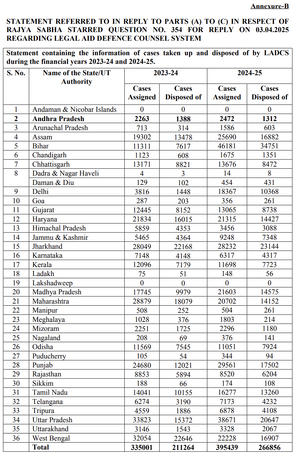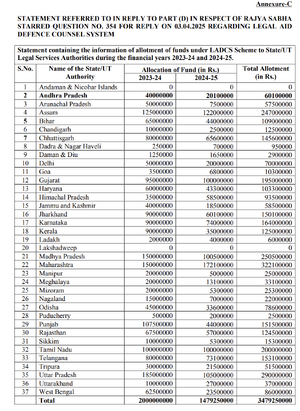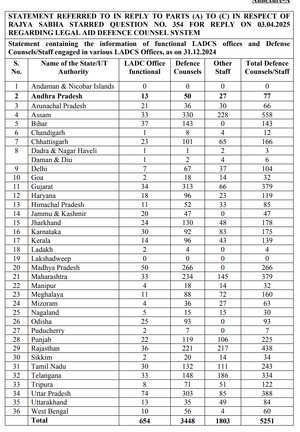Legal Aid Defence Counsel
What is Legal Aid Defence Counsel System [LADCS]
Legal Aid Defense Counsel System (LADCS) is a pilot program of NALSA where it involves the full-time engagement of lawyers in order to make legal aid services more efficient and to ensure that more persons in need actually access legal aid. Legal Aid Defense Counsel Office shall be dealing exclusively with legal aided matters in criminal matters of the District or HQ, wherein it is established. It shall be providing legal services from the early stages of criminal justice till the appellate stage, and the same shall include visits to jails to cater to the legal needs of unrepresented inmates.
Official Definition of LADCS
Article 39-A of Constituion of India, states that the state shall, in particular, provide free legal aid, through appropriate legislation or schemes, to ensure that no citizen's opportunities for securing justice are denied.
The state shall guarantee that all people are treated equally before the law and have access to a judicial system that maintains justice based on fairness, according to Article 14 of the Indian Constitution. In furtherance of which, the Indian Parliament incorporated Article 39A of the Constitution, which established free legal assistance as a basic principle.[1] Providing legal help to a poor accused who has been detained and placed in danger of losing his life or personal liberty is a fundamental need stipulated not only by Article 39-A but also by Articles 21 and 14 of the Constitution.[2]
LADCS is newly established under the Legal Services Authorities Act, 1987, the LADCS differs from the traditional system of appointing a legal aid lawyer from a floating pool of empanelled counsels. Instead, it establishes a team of full-time state- appointed lawyers, with staff and dedicated premises in districts, to provide legal assistance to indigent accused persons throughout the legal process, from pre-trial hearings to appeals.[3]
LADCS as defined in legislation(s)
As per the Modified Scheme circular of government 2022, in the process of strengthening and making legal services more professional, NALSA thought of adopting another legal aid delivery-based model i.e. "Legal aid Defense Counsel System' for proving legal aid in criminal matters on the lines of public defender system on pilot basis for a period of two years in some districts to see how effective and successful such changes in approach will be.
Legal provision(s) relating to LADCS
Legal Services Authorities Act, 1987
According to Section 2(c) of the Legal Services Authorities Act, 1987, “legal services” include any service in the conduct of any case or other legal proceeding before any court or other authority or tribunal and the giving of advice on any legal matter.[4]
In accordance with the Legal Services Authorities Act, 1987, Legal Services Authorities provide free aid to accused/ convicts, who are in custody or otherwise coming within the eligibility criteria spelt out in Section 12 of the Legal Services Authorities Act, 1987. Legal Services are being provided at pre-arrest, remand, trial and appellate stages in criminal matters.[5]
As per the Circular of NALSA, the details of LADCS scheme was further elaborated and the scope of work, along with the complexities of the scheme were exhibited.
Scope of Work
Legal Aid Defense Counsel Office shall be dealing exclusively with legal aided matters in criminal matters of the District or HQ, wherein it is established. It shall be providing legal services from the early stages of manners in criminal justice till appellate stage, and the same shall include visits to jails from catering to the legal needs of unrepresented inmates. It shall also undertake any other legal aid work related to District Courts or as assigned by the Secretary, DLSA.
Human Resource Mandate of LADCS
As per NALSA, a specific mandate of Human resource is to be maintained, i.e. Chief Legal Aid Defense Counsel, Deputy Chief Legal Aid Defense Counsel, Assistant Legal Aid Defense Counsel and Office Assistants/ Clerks. However, the number of Deputy and Assistant Legal aid Defense Counsel may be increased or decreased as per the requirement in individual districts, subject to prior approval of Hon’ble Executive Chairman, SLSA. Number of Legal Aid Defense Counsels shall be proportionate to the actual work and also requirement.
The Pilot project of LADCS was functional in 13 states, namely Andhra Pradesh, Chhattisgarh, Delhi, Gujarat, Jharkhand, Karnataka, Kerala, Maharashtra, Odisha, Rajasthan, Tamil Nadu, Uttarakhand, Uttar Pradesh.
Selection Process of LADCS
The applications for LADCS are invited as per public notice on the respective State’s Legal Service Authority's website. Each post requires a specific criteria to be fulfilled by the said candidate. The Counsels shall be engaged on contract basis in each place/district initially for a period of two years with a stipulation of extension on yearly basis subject to satisfactory performance. The performance of every human resource shall be assessed every six months by SLSA in consultation with DLSA concerned. The selection shall be carried out by Selection committee under the Chairmanship of the Principal District & Sessions Judge (Chairman, DLSA) as envisaged in NALSA (Free and Competent Legal Services) Regulations 2010, subject to final approval by the Executive Chairman, SLSA.
Criteria regarding Termination of LADC
The services of any human resource, including a Legal Aid Defense Counsel engaged in the office of the Legal Aid Defense Counsel, may be terminated at any time, without prior notice, by the Chairman of the DLSA on the recommendation of the Secretary, DLSA, or pursuant to written directions from the SLSA. The grounds for such termination includes (but not limited to) Malicious Practise, under the table remuneration, remaining absent for 2 or more weeks without any notice, etc.
The Role of SLSA and DLSA in the LADC Scheme
The State Legal Services Authorities (SLSA) and the District Legal Services Authority (DLSA) are responsible for establishing and functioning the Legal Aid Counsel System Office effectively. This includes planning for the office space, in-line with requirements, ideally, in or adjacent to the court complex and necessary infrastructure such as furniture, equipment including computers, printers, access to internet connectivity, office supplies and any additional equipment, and attaching or providing access to human resources for the Legal Aid Counsel System Office. They are also able to ensure the administration of the Legal Aid Counsel System Office and proper monitoring, mentoring and periodic evaluation of services.
They ensure to organize regular training (including refresher programmes) for legal aid counsels; renovate office premises and undertake limited renovations as necessary; ensure delivery of legal books, including Bare Acts and commentaries; develop and deliver access to software for legal research. Ensure timely monthly honorarium payments for legal aid counsels and employees; cover expert witness costs; incidental costs including travel; awareness campaigns; and undertake promotional programmes for the Legal Aid Defense Counsel Office.
LADCS as defined in official document(s)
State Legal Services Authority Circular inviting applications
- The Andhra Pradesh circular[6] inviting applications for the position lists the ‘Legal Aid Defense Counsel System’ (LADCS) as a scheme, in line with the public defender system, introduced by NALSA. As envisaged, LADCS involve full time engagement of lawyers with support system, dealing exclusively with legal aid work in criminal matters at every stage starting from the pre-arrest, arrest & remand stage to the conclusion of trials and appeals etc. This application was intended to fill the vacancy in 3 Districts of Andhra Pradesh, namely Prakasam, Srikakulam and Vizianagaram.
- UPSLSA circular it is necessary that Law schools should collaborate with Legal Services Institutions by sending their students for internships, and law college clinics also work closely with these institutions. In this context, law students can be engaged with the Legal Aid Defense Counsel Office to gain meaningful exposure to the practical aspects of criminal law, including preparing defense strategies and conducting legal research in various factual scenarios. Their engagement may involve legal research in criminal cases, visiting crime scenes, interviewing accused persons and their families as well as other relevant individuals, visiting prisons and legal aid clinics, participating in awareness campaigns, and assisting in examining prosecution evidence to provide inputs for an effective defense strategy. Such internships may be offered for a period of up to three months, during which no stipend will be paid by the Legal Services Authorities; however, on completion, a certificate detailing the nature and duration of work will be issued jointly by the Chief Defense Counsel and the Secretary, DLSA.
LADCS as defined in international instrument
UNODC’s Model Law on Legal Aid
The Public Defender System, as explained in international legal aid models such as the UNODC’s Model Law on Legal Aid, contemplates a system in which salaried legal representatives of the government, referred to as public defenders, are assigned to represent those individuals without the means to hire private counsel. Public defender systems are most often structured through the State, or an independent authority, which means it has full-time, formalized ensure access to legal representation services, especially in criminal cases. India’s Legal Aid Defense Counsel System (LADCS), has many components that can be configured in this structure. Under LADCS, full-time legal aid counsels are located in each district to represent only undertrial prisoners and other socio-economically marginalized accused persons. Legal aid counsels have a salary, work under the auspices of District Legal Services Authorities (DLSAs), and are prohibited from private practice - all ensuring that the delivery of public legal defense remains accountable, consistent, and safe for legal practice. It is important to view LADCS as a significant shift away from individual counsels' ad-hoc empanelment and toward a formalized public defender based delivery of legal aid services.
Official Database relating to LADCS
Parliamentary Response

State/UT-wise Details of cases taken up and disposed of by Legal Aid Defense Counsel System (LADCS) in the Country during 2023-24 and 2024-25
- Rajya Sabha Starred Q. No. 354, 3 April 2025: The LADCS (Legal Aid Defense Counsel System) serves to support the access to justice system by offering efficient legal defense to undertrial and neglected individuals without charge. As per the epicenter data provided under the national data sharing policy, LADCS assigned approximately 730440 cases across India in a span of two years. 335001 cases were in the year 2023-24 while 395439 were in the year 2024-25 as of 31 December 2024. Out of these, approximately 478120 were disposed of which means the overall disposal rate was approximately 65.5%. The information was gathered in connection to DLSA (District Level Service Authories) and reflects the trends of the LADCS with regard to the volumes and the results trends in performance. Some of the best performing states with relatively higher case volumes and disposals were Bihar with 57492 disposals, Uttar Pradesh with 36019, and Punjab with 29523 while Assam had 30360. Delhi, in particular, had a broad surge of utilization from 3816 cases in 2023-24 to 18367 in 2024-25 which indicates a rising awareness or access. Some states such as Meghalaya and Nagaland have higher assignment numbers, despite showing lower disposals, suggesting slower judicial pace or under-resourced bottlenecks.[7]

State/UT-wise Details of Funds Allocated under Legal Aid Defense Counsel System (LADCS) in the Country during 2023-24 and 2024-25
- Rajya Sabha Starred Q. No. 354, 3 April 2025, Part [D]: The Legal Aid Defense Counsel System (LADCS) is a centrally supported initiative by NALSA that institutionalizes the provision of free legal defense for under-trials and marginalized accused across India. The data on LADCS funding—sourced from a Rajya Sabha response (Starred Q. No. 354, 3 April 2025)—provides state/UT-wise allocations for the financial years 2023–24 and 2024–25, compiled under the National Data Sharing and Accessibility Policy (NDSAP). These figures are reported by implementing authorities and aggregated by the Department of Justice and NALSA for parliamentary oversight. For instance, Uttar Pradesh received the highest cumulative funding of ₹290 crore, followed by Maharashtra with ₹322.1 crore and Assam with ₹247 crore, reflecting both their population size and case burden. The structured allocation helps evaluate not only fiscal decentralization for legal aid but also reveals regional disparities, guiding future reforms and resource optimization in India’s public defense framework.[8]

State/UT-wise Number of Legal Aid Defense Counsel System (LADCS) Offices and Defense Counsels/Staff Engaged functioning in the country as on 31-12-2024
- Rajya Sabha Starred Q. No. 354, 3 April 2025, Part [A]: As of 31 December 2024, the Legal Aid Defense Counsel System (LADCS) has 654 functional offices in States and Union Territories. It employs a total of 5,251 people, including 3,448 full-time defense counsels and 1,803 support staff. The data collected from District Legal Services Authorities (DLSAs) and presented in the Rajya Sabha under the National Data Sharing and Accessibility Policy provides insight into infrastructure and human resource investment in India's legal aid system. This mapping is important because it helps identify regional differences and the extent of implementation in areas with high needs. Uttar Pradesh, with 74 LADCS offices and 388 total staff, has the largest institutional presence. Rajasthan, with 36 offices and 438 personnel, along with Assam (33 offices, 558 personnel) and Maharashtra (33 offices, 379 personnel), are also key contributors in legal aid human resources. Notably, some states like Bihar and Odisha, despite having many offices (37 and 25 respectively), report no support staff. This raises concerns about possible under-resourcing or incomplete reporting. In contrast, smaller states like Tripura and Sikkim have more balanced teams, indicating an early adoption of the model.[9]
International Experience of LADCS
It is pertinent to mention that in most countries, Legal Aid Delivery Models are combination of the Public Defender System, Assigned Counsel System and Contract Services System. Examples of diverse legal aid delivery systems can be found, among other countries,in Israel, the Republic of Moldova, Sierra Leone, South Africa and the United States of America. A number of jurisdictions have adopted a public defender scheme with offices throughout the country, including Argentina, Chile, Georgia, Mexico, Paraguay, Peru, the Philippines, the Republic of Moldova and South Africa.[10]
Research that engages with LADCS
Supreme Court issues detailed directions to Legal Services Authorities over access to Free Legal Aid for prison inmates (SCC Online)
This blog post by Sucheta, it is demonstrated that the Supreme Court, while hearing a writ petition on inhumane prison conditions, issued directions to NALSA, SLSAs and DLSAs to strengthen free legal aid for prisoners by improving the functioning of Prisoner Legal Aid Clinics, monitoring the Legal Aid Defence Counsel System, running awareness campaigns, ensuring timely interaction with inmates about their right to appeal, bridging gaps in undertrial releases, and digitising reporting. Referring to Article 39-A, the Legal Services Authorities Act, 1987 and key precedents, the Court stressed that free legal aid is part of Article 21 and asked High Courts to consider practice directions to inform convicts of this right.
Issues and Challenges
Even with the potential to be transformative, the Legal Aid Defense Counsel System (LADCS) is faced with challenges in implementation. There are regional inequities in staff capacity for implementation, inequitable states in disposal rates, and inefficiencies resulting from a lack of utilization or staff being unaware, or unable to utilize LADCS due to resource constraints or misunderstanding. Some states are assigning many cases, but disposing of very few. This indicates a bottleneck in legal capacity or coordination. The contractual arrangement of being engaged rather than permanent staff, the inherent lack of job security or guaranteed work incentives, are all issues that must be considered when evaluating service delivery. Furthermore, some administrative processes may involve delays, eg.; fund release for salaries or operations, infrastructure and systems set up for staff, or periodic evaluation of the system and its service offerings; this impacts predictable uniform service delivery. LADCS is a new pilot system and must resolve these operational gaps if it is to become a structured public defender system affording reasonable access to justice.
References
- ↑ https://articles.manupatra.com/article-details/Legal-Aid-in-India-current-scenario-and-future-challenges
- ↑ Sheela Barse vs. State of Maharashtra: MANU/SC/0437/1988.
- ↑ https://indiajusticereport.org/files/IJR%204_Full%20Report_English_Low.pdf
- ↑ Section 2(c), Legal Service Authority Act, 1987.
- ↑ http://nalsa.gov.in/legal-aid/
- ↑ Andhra Pradesh State Legal Services Authority, Amaravati Roc.No.49-E1/APSLSA/ LADCS/2022/ Date: 25.03.2023
- ↑ https://www.data.gov.in/resource/stateut-wise-number-cases-taken-and-disposed-through-legal-aid-defense-counsel-system
- ↑ https://www.data.gov.in/resource/stateut-wise-details-funds-allocated-under-legal-aid-defense-counsel-system-ladcs-country
- ↑ https://www.data.gov.in/resource/stateut-wise-number-legal-aid-defense-counsel-system-ladcs-offices-and-defense
- ↑ Model Law on Legal Aid in Criminal Justice Systems with Commentaries(www.unodc.org)
